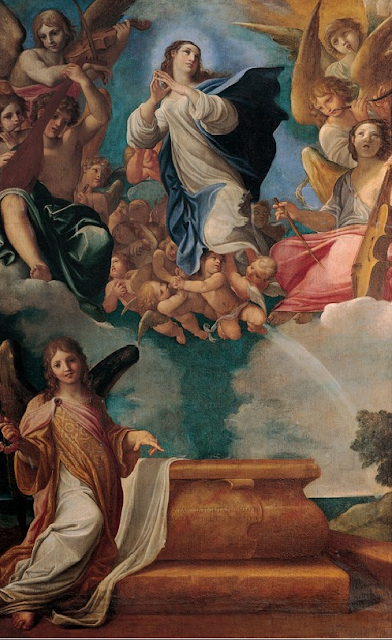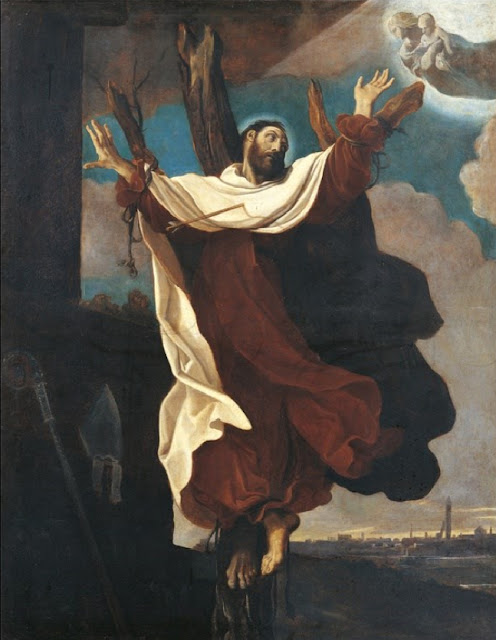 |
| Ludovico Carracci Salmacis and Hermaphroditus 1590s oil on canvas private collection |
 |
| Ludovico Carracci Bacchus and Aridane 1591-92 oil on canvas Museo Borgogna, Vercelli |
"When he was working on the lovely little picture of Bacchus and Ariadne for his beloved friend Cesare Rinaldi, Rinaldi asked him to use only the very finest colors, at which Ludovico gave a rather strange laugh and turned to him saying, "Good drawing, and the color of mud," alluding to Titian, who used to say (as Ridolfi reports) that "colors do not make the figures beautiful, but good drawing," and elsewhere that "lovely colors could be bought at the the Rialto, but drawing was in the safekeeping of the artist's genius."
 |
| Ludovico Carracci St Sebastian ca. 1600 oil on canvas Galleria Doria Pamphilj, Rome |
 |
| Ludovico Carracci San Rocco 1604-05 oil on canvas Pinacoteca Nazionale di Bologna |
 |
| Ludovico Carracci Portrait of Carlo Alberto Rati Opizzoni ca. 1597-1600 oil on canvas private collection |
 |
| Ludovico Carracci Christ in the Wilderness served by Angels ca. 1608 oil on canvas Gemäldegalerie, Staatliche Museen zu Berlin |
"It is amazing that among all the many pictures by Ludovico that are to be found in Bologna, no two figures or cast of features are exactly alike, not even when the subject is the same or when the identical characters are represented – a practice that not only none of the chief masters of our age like Rubens, Cortona, Domenichino, or Albani, but even the great leaders of the Lombard school, Parmigianino and Correggio, were unable to observe consistently, for in all their works, the heads, especially the heads of the putti, have a distinctive family likeness and resemble one another."
 |
| Ludovico Carracci Abraham and the Three Angels 1610-12 oil on canvas Pinacoteca Nazionale di Bologna |
| Ludovico Carracci Madonna & Child with Saints 1607 oil on copper Metropolitan Museum of Art, New York |
 |
| Ludovico Carracci Annunciation 1603-04 oil on canvas Musei di Strada Nuova, Genoa |
 |
| Ludovico Carracci Presentation in the Temple ca. 1605 oil on canvas Museo Thyssen-Bornemisza, Madrid |
"Let Ludovico therefore be recognized for the great master that he is, and let him not be deprived of the praise his great merit deserves. And let Painting, once languishing in such a disheartened state, acknowledge for all time its debt to him above all others for its new and worthier life. He before any one else attempted and brought about the harmonizing of the distinctive qualities of all the different schools; it was he who first accomplished the union of the finest drawing with the finest color, an achievement despaired of up to that time, and it was he who knew how to bring together all the concordant elements from the best styles and to compose an unheard of and marvelous harmony, which was to be carried on thereafter not only by his cousins but by all his students."
 |
| Ludovico Carracci Assumption of the Virgin 1606-07 oil on canvas Galleria Estense, Modena |
 |
| Ludovico Carracci Martyrdom of St Pietro Toma 1598-99 canvas Pinacoteca Nazionale di Bologna |
 |
| Ludovico Carracci Crucifixion with Biblical Patriarchs in Limbo 1616 canvas Chiesa di S Francesca Romana, Ferrara |
 |
| Ludovico Carracci An Angel Frees the Souls in Purgatory ca. 1610 canvas Vatican Pinacoteca |
"And so Ludovico outlived Annibale by ten years and Agostino by seventeen, showing absolutely no diminishment of his former powers as he grew older, and producing works no less stupendous than his earlier ones."
– Quotations are from Malvasia's Life of the Carracci, originally published in Italian in 1678, translated into English with commentary by Anne Summerscale (Pennsylvania State University Press, 2000)